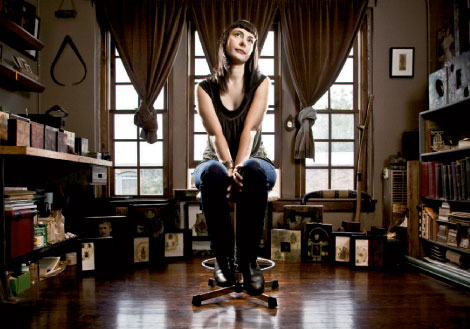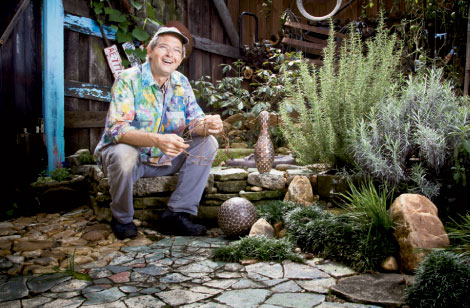Recycled Art
Recycled Art: Trash to Treasure: Meet three artists who give discarded objects a fresh interpretation
A yellow rubber duckie mounted on a tree stump is the first indication you’re on the right road to artist John Richards’ studio in Burnsville. A bumpy gravel driveway gives way to a clearing where sculptures made of wire and steel, glass and ceramics, wood and plastic surround a pond.
Richards, a self-described trash artist, might be surprised to find himself a poster-child for sustainable art these days. All his life, he’s collected objects and ephemera to make art. “At three, I discovered a mud puddle and rocks and sticks in the back yard, and the rest is history,” Richards says. But in a climate when reuse, reclaim, and sustainable are buzzwords of the environmental movement and art institutions are embracing the medium, his artwork is finding a broader audience.
Hand in Hand gallery in Flat Rock recently held a recycled art exhibition. This summer, Asheville’s Grovewood Gallery invitational exhibit “Sculpture for the Garden” included environmental art and recycled works. And the McDowell Arts Council Association (MACA) gallery showcased sculptor Jeff Menzer’s recycled works earlier this year.
“We’re riding a groundswell of interest in sustainability and looking at the different aspects of our lives and the way we impact what’s around us. A lot of artists are looking at this,” says David Voorhees, artist and co-owner of Hand in Hand.
Whether this is a movement, philosophy, or zeitgeist, Richards prefers to leave the discussion to the critics, continuing to make art out of the things that capture his fascination. In his Yummy Mud Puddle Studio, doorknobs, plastic parts, bottle caps, trophies, wire, yarn, action figures, pill bottles, pipe cleaners, computer chip boards, and thousands of other bits and pieces are corralled in boxes, drawers, and buckets that are neatly marked and classified. Friends now come to him with boxes of castoffs. “People say I’m so organized, but I have to be,” says Richards, “or else the idea slips away.”
Early Influence

A child of the Great Depression, it’s no wonder Richards began imagining a new use for every object he came across. “The whole idea of how much people throw out and the obsolescence of things is incredible,” says Richards. “The idea of the boxes of things that we have ‘just in case’ is mind-boggling.”
Influenced by Dada and surrealism, he continues to hone his assemblages—paper lamps with drawings and writ, little and large alters, figures, portraits, and other sculptures.
The need that marked the era of Richards’ childhood typifies the most basic origins of sustainable and reclamation art. “Necessity is primary,” says Rebecca Hofburger, founder and director of the American Visionary Art Museum in Baltimore, which exhibits contemporary and historic works by self-taught artists. For instance, she says, when there’s no money for art materials, things like the corrugated metal roofs or old car windshields make great natural canvases.
The very nature of genius, says Hofburger, is to see opportunity and new relationships in everyday objects—perceiving in them a hidden magic or potential that others don’t.
Process of Discovery

Artist Nicole McConville has been creating works of art with found objects for 10 years. Vintage photographs, delicate feathers, the odd animal bone, and stamped patterns find their way into her miniature assemblages. Similar to Victorian shadowboxes, or Wunderkammer (cabinets of curiosity) of the 17th century, the pieces often employ beeswax, dammar resin, paints, and adhesives.
“I’m always on the prowl,” says McConville of searching for the objects that fuel her process. “Sometimes I choose them, and in odd circumstances, they choose me,” she notes. “It might sound a bit cliché, but I really do know it when I see it. If I’m wandering the aisles of a flea market or antique mall, digging through boxes of old photos, or rummaging through a friend’s basement, I’m just looking for something that truly grabs my attention in a way that almost demands that it be used.”
A moment of connection for McConville can come through a face in an old photograph, a beautifully worn book, a quirky piece of rusty metal, or a wooden box that’s just the right shape or size. Half the enjoyment in the creative process, she says, is the act of discovery undergone as a work comes together. With a studio that could quickly overflow with must-have detritus, she says, creative discernment is key to gathering only those materials that she intends to use.
So, she has also become mindful of what and how she gathers her soon-to-be objects d’art. “Some of my natural specimens have either been found or given to me, but most of what I’ve used in recent years has been bought from legitimate suppliers to ensure that they have been sourced in a sustainable manner,” says McConville. “I want to feel good about everything I put into my work.”
Lesson Plan

While McConville employs a thoughtful methodology in searching for her materials, sculptor and landscaper Menzer delves into the thick of it—scouring metal yards, scrap heaps, and junkyards, sometimes braving cuts or scrapes and back injury, as he carts heavy industrial pieces back to his West Asheville home and studio.
As a teacher at John C. Campbell Folk School, Menzer shares his philosophy with students: “Art is for everybody,” he says. “Art supplies don’t have to cost a fortune. They can be whatever you have.”
Schools across the country are catching on to that ideology. “Art teachers and students are infusing their traditional schooling with respect for harnessing abundant and reusable materials,” says Hofburger. “This trend keeps in line with current and growing green thinking and is a natural way to inspire greater creative self-reliance.”
Menzer has conducted classes of another sort with a new generation of budding artists in McDowell County schools through the Mountain Arts Program and MACA’s artist-in-residence series. He guided sixth-graders at Glenwood Elementary School through the creative and constructive process of building self-portraits using reclaimed, scrapped, and found materials, a process he calls “re-art.”
“I’m revisiting some things I did 40 years ago,” says the 56-year-old, recalling summers spent pioneering, building bridges and signal towers out of found and natural objects at Boy Scout camp. “We’d disassemble them, then put them back together again the next week,” he explains.
Menzer also incorporates his larger industrial found objects into garden landscape designs, a parallel business he runs with his wife. “I spent three years in art school and spent a fortune on paper and paints,” Menzer recalls of a turning point in his artistic education. “My reaction to that was I became much more interested in the quality of found materials as compared with the sterility of store-bought materials. They have no story,” says Menzer. “As an artist you can put your story into them, but they don’t come with anything. Things have a much better story if they came out of my grandpa’s garage.”
To McConville, the experience hints at reincarnation. “By reclaiming these often dusty, worn, neglected objects and providing a new environment—a new context for them,” she reasons, “you can reinvent their narrative while also honoring the remnant stories from their past.”
- Richards’ work is exhibited at Grovewood Gallery in Asheville, Art Walk in Boone, and the Toe River Arts Council gift shops in Burnsville and Spruce Pine. www.yummymudpuddle.com
- See McConville’s pieces at The Satellite Gallery in Asheville.
- Menzer's work is in many private gardens and collections. He and his wife, Annie, operate The Natural Gardeners in Asheville.
